The Adventures of Chilunda, A Zambian Black Rhino
How collaboration between animal experts, government officials, and curious citizens protected a wayward rhino who wandered beyond the safety of his national park
Chilunda, a young black rhino, is back home in Zambia. / Ed Sayer, NLCP
Most people can relate to a dog or cat going missing from their home. But what about a rhino? In 2021, a young black rhino broke out of his home in Zambia’s North Luangwa National Park and wandered to a remote area 136 miles away.
A ranger from Conservation South Luangwa (CSL), North Luangwa’s neighbor, first spotted the missing rhino — named Chilunda after a brave ranger who lost his life to poachers — during aerial monitoring of wild dogs.
Authorities realized that they needed to act quickly. Although Zambia’s North Luangwa Conservation Programme (NLCP) had reintroduced black rhinos into the park in 2003, and had helped grow the once extinct population, rhinos continue to be targeted and killed for their horns.
It was time to call in NLCP’s Rhino & Elephant Protection Unit (REPU). REPU, established in 2014, is a team of highly trained male and female wildlife officers from local North Luangwa communities who risk their lives every day to protect the animals that share their home.
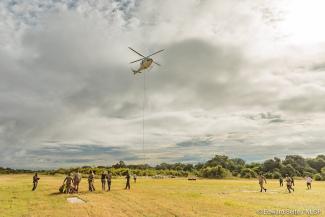
Established partnerships that include USAID, animal experts, and government officials — plus curious citizens keeping watch on the ground — helped keep a wayward black rhino safe and eventually brought him back home.
Edward Selfe, NLCP
REPU, supported by the USAID Luangwa Livelihood and Conservation activity and implemented by Frankfurt Zoological Society and its partners, works to safeguard the black rhinos of North Luangwa National Park. While some young adult rhinos (mostly males) escape, typically pushed away by larger, dominant males, they are tracked, secured, and, if necessary, recaptured and transported back to the park.
But Chilunda had strayed far outside of REPU’s operational area. With almost no road access into the area, and with the oncoming rainy season potentially hampering mobility across the valley, it was clear that this would be no ordinary rescue.
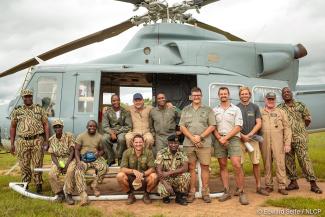
A team of experts helped bring Chilunda home safely using a slinging technique and a large helicopter.
Edward Selfe, NLCP
NLCP sought advice from African conservationists who had pioneered ‘slinging’ rhinos from large helicopters. Although the slinging technique had never been attempted in Zambia, and never over such a long distance, it soon became the only viable option to get Chilunda home.
Over the next few months, NLCP, with surveillance support from the CSL’s and Zambia Carnivore Programme aircraft, did their best to protect Chilunda as they gathered advice, equipment, and expertise. Local community members also stepped in to help, notifying FZS when they spotted Chilunda outside the protection of the national park.
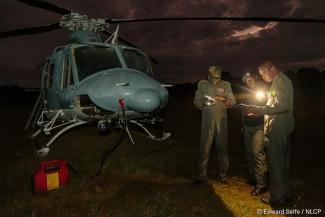
Rescuing the rhino took careful planning.
Edward Selfe, NLCP
After months of planning and tracking, the team, supported by the Zambian Air Force, Parsons Aviation, and local company Niner Juliet Logistics, was ready for their remarkable rescue mission. They rose before dawn, and under the watchful gaze of a pack of wild dogs, lifted off with high spirits.
The team soon located Chilunda and darted him with a tranquilizer. One member of the team, Ranger Paimolo Bwalya, voiced the mixed emotions of that moment. “I was very relieved,” he said, “but straight away started worrying about his journey back.”
Once immobilized, veterinarians stabilized Chilunda while team members attached the sling and began the lift back.



After being tranquilized, Chilunda is harnessed to a waiting helicopter. His walkabout attracted attention from local citizens keen to help rescuers recover Chilunda and safely return him home. Said Ranger Paimolo Bwalya, after the rhino was found: “I was very relieved, but straight away started worrying about his journey back.” However the rescue was a success. Chilunda was carefully lowered to the ground and moved into a holding enclosure. / Edward Selfe, NLCP
With the rhino safely airborne — a sight to see for anyone the chopper happened to fly over — the vets flew ahead while support staff stayed close to the chopper to coordinate operations. The team made two stops to refuel and complete vet checks on the rhino in order to keep the sedation topped up and release the slinging pressure to allow circulation to the rhino’s legs.
The journey provided a unique sight for those community members who happened to pass by.
“I was very happy to see Chilunda … [and] happier that the young and old people of Nabwalya were able to see an animal which they had only seen on papers or TVs before,” says Chief Nabwalya, who lives in one of the communities that helped monitor the rhino during his escape and stopped by to assist the vet checks. “That day was a very great day for everyone.”
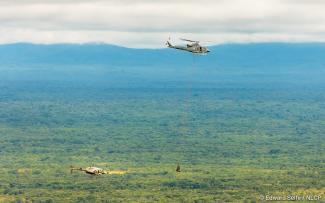
While the rhino was in transit, the vets flew ahead and support staff stayed close to the chopper to coordinate operations.
Edward Selfe, NLCP
Finally, after four hours — compared to an estimated 36-hour road trip — the rhino arrived safely back home where he was carefully lowered to the ground and moved into a holding enclosure.
Despite his harrowing journey, the black rhino quickly started eating normally and showed no signs of any ill effects from his adventure. Chilunda now wears tracking transmitters so teams can monitor his movements — and, with any luck, prevent a second walkabout.
From planning and logistics to cutting-edge veterinary and physiological care, Chilunda’s rescue was made possible by extraordinary collaboration between Zambian state agencies and conservation NGOs, along with support from private sector partners and everyday citizens on the ground.
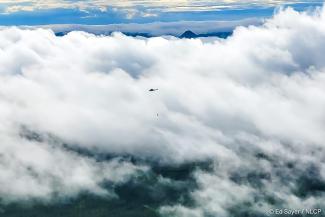
Take a close look: Chilunda and his rescuers fly through the clouds on their way back to Zambia’s North Luangwa National Park — a 136-mile journey.
Chilunda’s adventure is a reminder of the work still to be done to protect wildlife in Zambia and beyond. It also highlights the passion that wildlife rangers bring to conservation and the importance of expanding conservation efforts beyond the borders of national parks to the local communities which surround them. For wildlife conservation to truly succeed, its ideas must be embraced by the local communities that live alongside that wildlife.
Chilunda is now living peacefully within the NLNP, and according to Ranger Paimolo, most of the time can be found with a young female rhino, Buseko.
He remains under the watchful eye of the local wildlife scouts ready to step in if he decides to go on another adventure!
ABOUT THE AUTHOR
Morgan Siddle is the Development Outreach and Communications Specialist at USAID’s Mission in Zambia.

